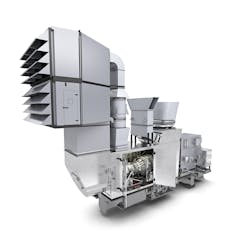In recent years, offshore operators have faced greater pressure to reduce capital investment and increase production capacity. In response, the demand for gas turbine solutions that can efficiently deliver the power to exploit resources in deeper waters has grown immensely. Gas turbines meet the needs of project developers to reduce emissions and minimize the size and weight of topsides. The latter is especially important for floating, production, storage, and offloading (FPSO) vessels, as reduction in module weight and footprint can reduce facility development costs and increase options for topsides configurations.
Siemens says that its SGT-A35 gas turbine (formerly known as the Industrial RB211) has emerged as a preferred solution for delivering on key performance indicators (KPIs) in today’s offshore environment.
In 2018, Siemens supplied six SGT-A35 (GT30) gas turbine packages for the FPSO Carioca MV30, located in the presalt region of the Santos basin approximately 250 km (155 mi) off the coast of Rio de Janeiro, Brazil. The facility will be deployed in the Sépia field owned by Petrobras. MODEC will engineer, construct, and operate the facility.
Four SGT-A35 packages will be used to provide power generation for the vessel. Siemens says that high power density is achieved through a system architecture that incorporates a lightweight, proven aeroderivative free power turbine module optimized to operate at synchronous speed to a 2-pole A/C generator. In this configuration, the free power turbine can direct-drive an electrical generator at either 60 Hz or 50 Hz frequency without the need for a step-down gearbox, which results in substantial weight and space savings, according to the company. Compared to the conventional Industrial RB211 predecessors, the SGT-A35 offshore package is 30% lighter with a much smaller footprint.
Siemens says that the same gas turbine package can also operate in mechanical drive mode for compression or pumping service. On the FPSO Carioca MV30, two additional SGT-A35 turbines will be used to drive DATUM compressors. The compression trains will reinject CO2 to pressurize the reservoir at more than 3,600 psi. As part of the agreement, Siemens will provide service and maintenance for the all six SGT-A35 and associated components over a period of 21 years.
Siemens recently received another order for three additional SGT-A35 power generation packages to power an FPSO vessel approximately 10 km (6 mi) off the coast of Mexico.
The company says that the SGT-A35 (GT30) is available in two variants, ISO-rated at 34 MW and 38 MW. The higher rating is made possible by the integration of an additional stage in the compression section of the gas turbine (zero-stage). Designed to the latest aerospace standards and seamlessly integrated within the core engine in order to keep its external interfaces unchanged, the addition of the zero-stage provides 10% additional power with only a minimal weight increase and without any change in the configuration of the turbine hot section or its firing temperature, thus providing a low-risk solution for the power up-rate. The SGT-A35 (GT30) is available with dual fuel capability, with or without dry low emissions (DLE) combustion. With DLE, emission levels of 25 ppm (dry at 15% O2) for NOx and CO2 can be achieved.
Another key advantage of the SGT-A35 is the agile twin-spool architecture, which enables operators to restart the turbine following a shutdown at any time (i.e., no “hot lockout” conditions). This allows operators to restore power rapidly after a shutdown to ensure maximum equipment availability. The turbine can be safely exchanged onsite within 24 hours, reducing downtime even further and minimizing costs associated with non-productive time (NPT).
The SGT-A35 is designed to operate on a range of gaseous and liquid fuels. Automatic changeover between fuels is permissible while the turbine is running. Units have been tested with gaseous fuel compositions that contain a high proportion of inert gases (up to 50% by volume), which are common in many deepwater plays. The thermal efficiency of the gas turbine exceeds 40% at ISO conditions. It retains more than 90% of its ISO power output up to 86°F (30°C), making it well suited for operation in hot climates.
Siemens reports that in 2018, more than 10 offshore orders were placed for the SGT-A35 (GT30) worldwide. The company says that these orders are a testament to the advantages the turbine package can provide in offshore applications, particularly FPSOs, where the need to minimize footprint and weight, while still meeting requirements for power density, availability, and emissions have become critical to successful operation. •



